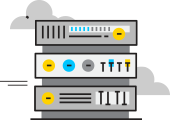A Host-based firewall is a vital security measure used to protect a website from unauthorized access, malware, and cyberattacks. As a form of firewall, it operates at the host level, analyzing incoming and outgoing network traffic to determine whether it should be allowed or blocked. In this article, we explore the history, structure, features, types, and future perspectives of Host-based firewalls, with a particular focus on its relevance to the proxy server provider OneProxy.
The history of the origin of Host-based firewall and the first mention of it
The concept of firewalls dates back to the 1980s when the internet was in its infancy. The first known mention of a firewall was in the 1988 document “The Anderson Report,” which described a system designed to protect sensitive data and resources from unauthorized access. Initially, firewalls were typically deployed as perimeter-based solutions, guarding network boundaries between internal systems and the external internet. However, as threats evolved, it became evident that additional protection was needed at the host level, leading to the development of Host-based firewalls.
Detailed information about Host-based firewall. Expanding the topic Host-based firewall
A Host-based firewall, also known as a personal firewall or endpoint firewall, is installed and operated on individual devices, such as servers, workstations, or web hosting platforms. Unlike network firewalls, which protect entire networks, Host-based firewalls focus on securing individual hosts or endpoints. By operating closer to the application layer, they can provide granular control over network traffic, allowing for more precise security configurations tailored to the specific requirements of the host.
The internal structure of the Host-based firewall. How the Host-based firewall works
The internal structure of a Host-based firewall involves several components that work in tandem to safeguard the host. These components include:
-
Packet Filtering: This is the core functionality of the Host-based firewall. It examines each incoming and outgoing packet and decides whether to permit or deny its transmission based on predefined rules.
-
Stateful Inspection: A Host-based firewall maintains a record of the state of active connections and uses this information to determine whether incoming packets are part of an established connection or potential threats.
-
Application Layer Filtering: This layer inspects packets at the application level, allowing the firewall to understand the specific application or service generating the traffic. This feature enables more nuanced control over allowed activities.
-
Intrusion Detection and Prevention System (IDPS): Some advanced Host-based firewalls incorporate IDPS functionality, which can identify and block suspicious activities or potential attacks based on known patterns and heuristics.
Analysis of the key features of Host-based firewall
Host-based firewalls offer several key features that make them an essential security tool for websites and servers:
-
Granular Control: Host-based firewalls allow administrators to set specific rules for individual hosts, offering precise control over what network traffic is permitted.
-
Enhanced Security: By operating at the host level, these firewalls can protect against threats that may not be detected by network-level firewalls.
-
Application Awareness: The ability to inspect packets at the application layer enables the firewall to identify and block application-specific threats.
-
Dynamic Rule Updates: Host-based firewalls can be updated more quickly than network firewalls, ensuring that the latest threat definitions and security rules are implemented promptly.
Types of Host-based firewall
Host-based firewalls can be categorized based on their deployment and functionality. Here are the main types:
| Type | Description |
|---|---|
| Software Firewall | Installed as a software application on the host operating system, providing protection at the endpoint level. |
| Hardware Firewall | Implemented as a dedicated hardware device placed between the host and the network, often used for high-security requirements. |
| Web Application Firewall (WAF) | A specialized type of Host-based firewall that focuses on protecting web applications and APIs from specific web-based threats. |
Ways to use Host-based firewall:
-
Protecting Web Servers: Host-based firewalls play a crucial role in securing web servers from various attacks, such as DDoS, SQL injection, and cross-site scripting (XSS).
-
Controlling Outbound Traffic: Administrators can use Host-based firewalls to regulate the types of outgoing traffic allowed from the host, preventing potential data exfiltration.
-
Enhancing Endpoint Security: By providing an additional layer of defense at the endpoint level, Host-based firewalls complement other security solutions and reduce the attack surface.
-
Performance Impact: Intensive packet inspection can sometimes affect host performance. To mitigate this, hardware-accelerated Host-based firewalls and optimized rule sets can be employed.
-
False Positives: Overly restrictive firewall rules can lead to false positives, blocking legitimate traffic. Regular monitoring and fine-tuning of rules can resolve this issue.
-
Complex Configuration: Host-based firewalls require careful configuration tailored to the host’s requirements. Employing default configurations and automated tools can simplify the setup process.
Main characteristics and other comparisons with similar terms in the form of tables and lists
| Characteristic | Host-based Firewall | Network Firewall |
|---|---|---|
| Deployment Scope | Individual hosts and endpoints | Entire networks |
| Location | Operates on the host device itself | Typically located at network boundaries |
| Traffic Control | Granular control over specific hosts | Broad control over all network traffic |
| Application Awareness | Yes | Limited or no application awareness |
| Protection Level | Protects hosts and endpoints directly | Protects network and its connected hosts |
| Ease of Management | May require individual configuration | Centralized management for all devices |
The future of Host-based firewalls holds exciting possibilities, driven by emerging technologies and evolving cyber threats. Some potential developments include:
-
Artificial Intelligence (AI) Integration: AI-powered Host-based firewalls can better identify and respond to zero-day threats and unknown attack vectors.
-
Behavioral Analysis: Future Host-based firewalls may incorporate advanced behavioral analysis to detect anomalies in application behavior, enhancing protection against sophisticated attacks.
-
IoT Security: With the proliferation of Internet of Things (IoT) devices, Host-based firewalls may expand their reach to protect smart devices at the endpoint level.
How proxy servers can be used or associated with Host-based firewall
Proxy servers, such as those provided by OneProxy (oneproxy.pro), can be effectively combined with Host-based firewalls to enhance website security. By routing all incoming requests through the proxy server before reaching the host, the firewall gains an additional layer of protection. This setup helps hide the actual IP address of the host, making it harder for attackers to directly target the server. Furthermore, the proxy server can act as a buffer, filtering out potential threats and malicious traffic before they reach the host, thus relieving some of the firewall’s processing burden.
Related links
For more information about Host-based firewalls and website security, consider exploring the following resources:
-
NIST Special Publication 800-41 Rev. 1 – Guidelines on Firewalls and Firewall Policy from the National Institute of Standards and Technology.
-
OWASP Web Application Firewall – An overview of web application firewalls, a specialized type of Host-based firewall.
-
Cisco Adaptive Security Appliance (ASA) Firewalls – Information about Cisco ASA firewalls, which combine network and Host-based firewall functionalities.
In conclusion, Host-based firewalls are crucial components of website security, providing granular control, enhanced protection, and application awareness at the endpoint level. When combined with proxy servers like those offered by OneProxy, these firewalls can significantly bolster a website’s defenses against cyber threats, ensuring a safe and secure online presence.




